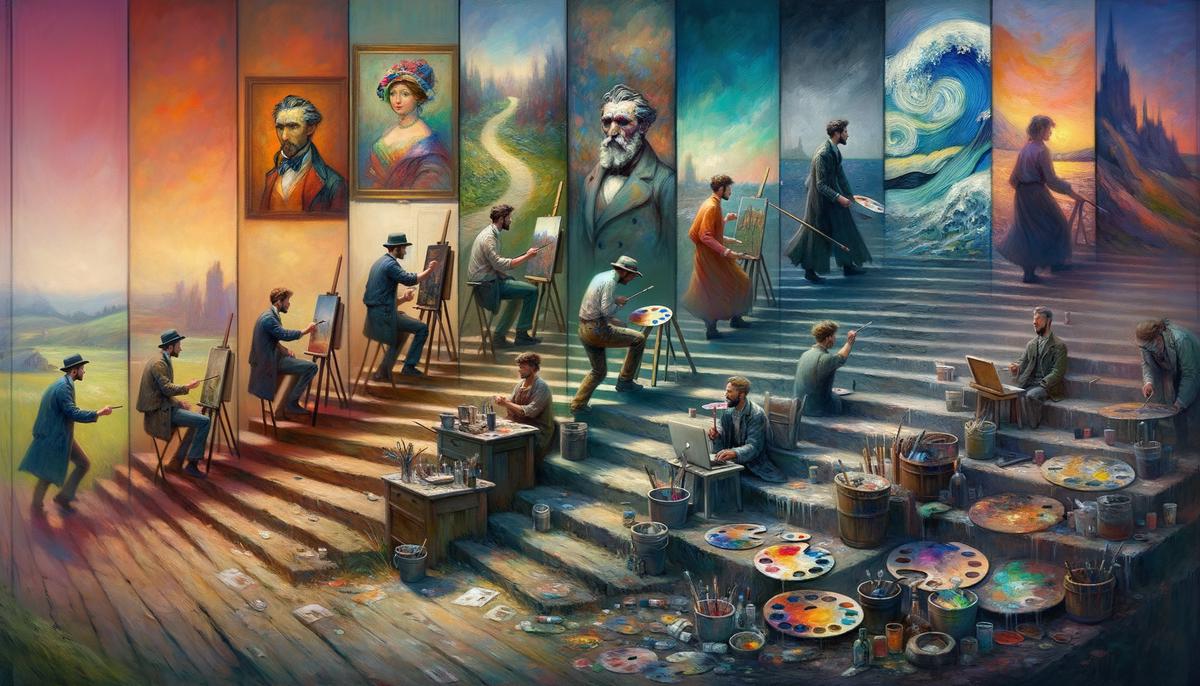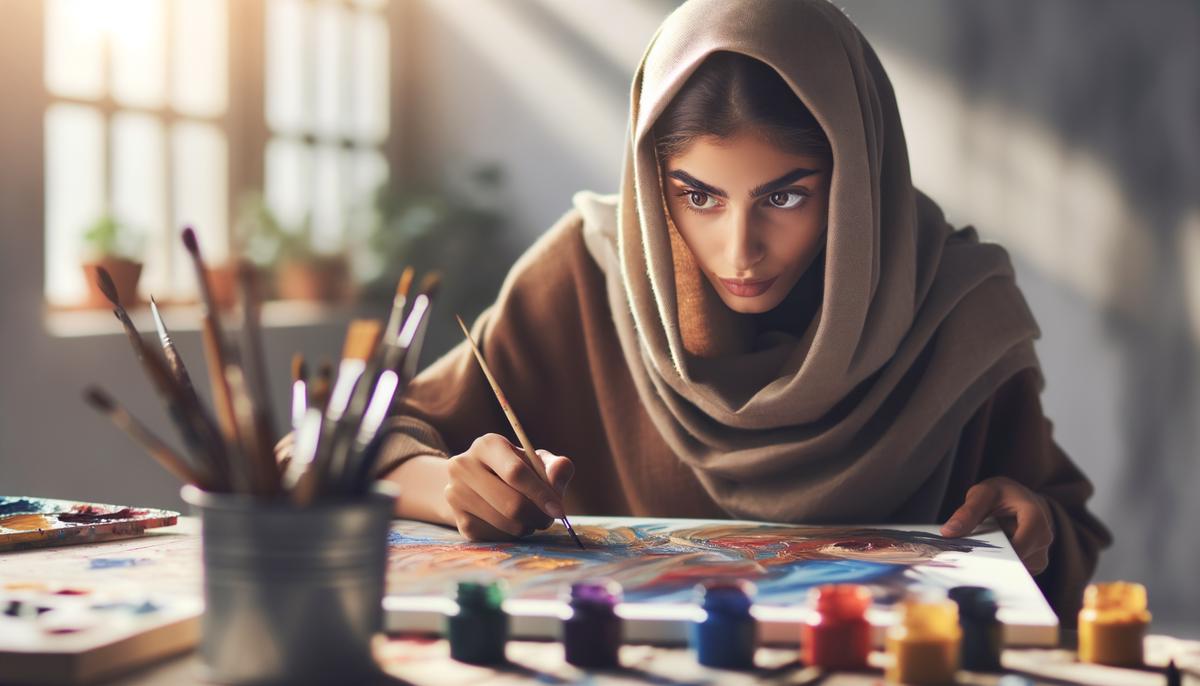Delving into the complex labyrinth of creativity, one embarks on a remarkable journey toward discovering their unique artistic fingerprint. This voyage of self-exploration is a compelling odyssey that transcends mere technical mastery, tapping into the core of one’s intrinsic inspirations and aesthetic leanings. As an intrepid explorer in the vast expanse of artistic expression, the quest to find your art style is as much about introspection as it is about the outward study of artistic heritage. It is in the rich soil of your preferences, elucidated by the relentless pursuit of personalized themes and mediums, that the seeds of your distinctive style are sown.
Self-Exploration
Title: The Intimate Dance of Self-Exploration in Carving Your Unique Artistic Voice
In the pulsating heart of London’s art scene, change is the only constant, and every corner turned unveils a canvas for self-discovery. For artists, London isn’t merely a city; it’s a living, breathing muse whispering secrets of self-exploration—a vital journey for those searching to find their own distinctive art style.
Unearthing one’s artistic identity is akin to peeling back the layers of one’s soul. Dare to delve deep. The first stroke on a blank canvas is not just paint; it’s the first word of one’s inner dialogue. Each colour, each line resonates with the frequencies of one’s personal experiences and emotions.
Engage with the world. Be a sponge—soak up every display, from the audacity of street art in Shoreditch to the hallowed halls of the Tate Modern. Step outside the comfort zone, absorb the diverse forms of visual dialects spattered across the city. This isn’t about imitation; it’s about inspiration. How do those mediums echo in the depths of one’s psyche? It’s about translation—how one decodes the influence and re-emits it with a personal flair.
Reflect, relentlessly. Peering inwards is as crucial as observing outwardly. Why does a certain texture, stroke or palette stir that flutter in the chest? Questions are compasses; answers, destinations. Allow the quirks, the passions, the fears to seep into the work. Artistic style is born from this raw honesty—this courageous display of uniqueness.
Experiment without trepidation. London thrives on transformation, and so should one’s art. The city’s art students treat their studios as alchemic labs, where the boldest experiments culminate in the most serendipitous eurekas. Mix mediums, defy genres, and dismantle the constructs of labels. It isn’t about creating what sells; it’s about creating what resonates.
Embrace critique, whether it’s the approving nod of an aged professor or the raised eyebrow of a fellow café squatter. Critique fuels growth, chiselling away the excess to reveal the essence underneath. It’s not about seeking approval, though; it’s about shaping perspective. It’s about toughening the exterior so the art remains undiluted.
Sync with time. The relentless march of the clock sculpts and sands an artist, just as it does art. With the passing of seasons and experiences, artistic style morphs. London, ever the chameleon, reminds one that change isn’t just inevitable; it’s desirable.
Self-exploration is the cornerstone of establishing one’s art style—it is an odyssey without an end, spiralling deeper into one’s core with every creation. Allow the journey to be a fearless plunge into the unknown, knowing that each step taken is a stroke closer to the masterpiece of self, perpetually evolving, perpetually refining. It’s not about the destination; it is, has been, and always will be about the adventure.

Study and Imitate
Diving headlong into the bustling labyrinth of London’s art scene can make for a dizzying adventure. Yet, it’s within these winding corridors that one finds the raw materials to forge an artistic identity. Amid the clinking of pint glasses and the whisper of paintbrushes, lie lessons from past maestros that can shape our creative futures.
Studying and imitating other artists is not merely an academic exercise; it serves as a springboard to propel our craft into realms uncharted. Like sponges beneath the Thames, we soak in the essence of those who’ve sketched their souls onto blank canvases, allowing their methods to meld with our musings.
Embark on a pilgrimage to the great galleries—the Tate, the Saatchi or the lesser-known hideaways like The Crypt Gallery—allowing the spectral hands of great artists to guide your own. Absorb their choice of hues, their brushwork, their configuration of chiaroscuro. What emotion do their lines evoke? What message hums in the spacing of their strokes? Through this visual conversation, we begin to see not with our eyes, but through the eyes of those who’ve carved their names into art’s ever-growing story.
To harness these insights, one must endure the sacrament of repetition. Reproduce the classics, stroke for stroke, tone for tone. Understand that within each copy lies a lesson. As you replicate the works of Hockney, Turner or Hepworth, watch as their spirits dance within your muscle memory. These practices are not about imitation as an end, but as a means to crack the code of visual language that will soon spell out your unique dialect.
Venture further; dissect the contemporary, mix with the movements that break convention. What does a Banksy stencil teach us about impact? How does Tracey Emin convey raw emotion through fabric and ink? By deconstructing these modern messages, we construct a lexicon of techniques that becomes ours to command.
Yet, embracing the precision of old masters is as crucial as absorbing the rebellion of new ones. Relive the Renaissance within your sketchbook, but bend it to today’s narrative. Can the Baroque’s dramatic illumination illuminate your own profound experiences? How might van Eyck’s detail orientation sharpen your observational skills? Each technique refined is another voice in the conversation of your emerging style.
No transformation is greater than the metamorphosis of art. As you shift from emulating to innovating, norm becomes anomaly, and the familiar strange. The intersection where once stood a copyist gives way to a trailblazer with a quiver of honed skills and a palette of individuality.
What awaits then, is not merely finding but forging your artistic style, through the fires of introspection and the anvils of history. It is there, amongst the myriad of canvases behind and ahead of you, that your artistic voice shouts loudest, shaped and strengthened by the symphony of artists before you, uniquely yours and yet part of the grand continuum that is the art world.
Remember, to stand upon the shoulders of giants is not to weigh them down, but to gain perspective. The view from up high is vast, breathtaking. Congruently, your artwork becomes a beacon—a testament that art is not static, but a medium that evolves with each brush-stroke of influence from those who dare to dream in colour.

Consistent Practice
Diving into the crucible of consistent practice, it becomes starkly apparent just how vital it is in chiselling out a distinct art style. In the ever-thrumming, ever-changing art landscape of London, where a tapestry of styles and expressions span across every nook and gallery, practice emerges as the linchpin in an artist’s quest for an individual voice.
But why, one may ponder, is regular dedication to one’s craft so emphatically preached by tutors garbed in splattered smocks and by peers with charcoal-smeared fingers? It’s because inherent within the very fabric of practice lies the key to unlocking artistic potential, discovery, and ultimately, mastery.
Consistent practice presents a terra firma on which the bedrock of technical finesse is forged. Through the repetition of strokes, the manipulation of mediums, and the rhythmic dance of the artist’s hand, one not only hones their skills but infuses them with muscle memory. It’s this incessant sharpening of technique that affords the freedom to then deviate, twist, and turn until something unmistakably personal emerges.
Moreover, regularity in creation carves a path through the thicket of ideas that crowd the artist’s mind. To distil the cacophony of inspiration into a singular, recognisable echo of one’s true style, there must be a disciplined approach to practice. Reiteration acts as a sieve—sifting through influences, refining thought threads, and amalgamating disparate elements into a coherent collective that sings of the artist’s unique perspective.
An unwavering practice schedule is also a beacon that guides one through the tumultuous seas of creative blocks and the doldrums of lacklustre motivation. It is the compass by which an artist navigates, ensuring that even in times of drought, the wellspring of creativity is not left barren. The act of showing up to the canvas, sketchpad, or installation — even when muse and motivation flicker — stokes the embers of innovation and keeps the flame of passion alive.
And let’s not overlook the iterative process, shall we? Each piece produced carries within it the genetic code for improvement, a stepping stone towards a pinnacle of expression. Whether it be through nuanced shading or bold gestural marks, each work created is a lesson unto itself. Failures and successes alike become invaluable teachers, imparting wisdom that calcifies into the bones of one’s growing style.
In the vibrant melee of London’s art scene, where yesterday’s avant-garde becomes today’s classical, and tomorrow’s unknown is ripe with potential, it is the artist with a steadfast practice that weaves their mark into the tapestry of legacy. This steadfast diligence, akin to the slow, determined chisel of a sculptor, is what eventually reveals the masterpiece of an individual’s artistic identity, a style that stands resilient amidst an ever-shifting tableau.
In closing, remember, the cadence of consistent practice is the lifeblood of any artist serious about defining a distinct, evolutionary style. It is in the calm and chaos of continual practice that the essence of an artist’s true nature is distilled—a journey not summed up in a mere summary but lived and breathed in the vibrancy of the ever-expansive art world.

The journey to uncovering one’s art style is an endless exploration marked by the imprints of one’s unique experiences and artistic ventures. As the pathways of creative influence converge within the crucible of consistent practice, what emerges is a style that is inherently reflective of the individual’s journey—a visual lexicon defined not only by proficiency but by the nuanced tales of personal evolution. In this unceasing pursuit, the artist’s hand becomes a vessel for a lexicon of creative expression that resonates with the authenticity of their singular narrative.
























